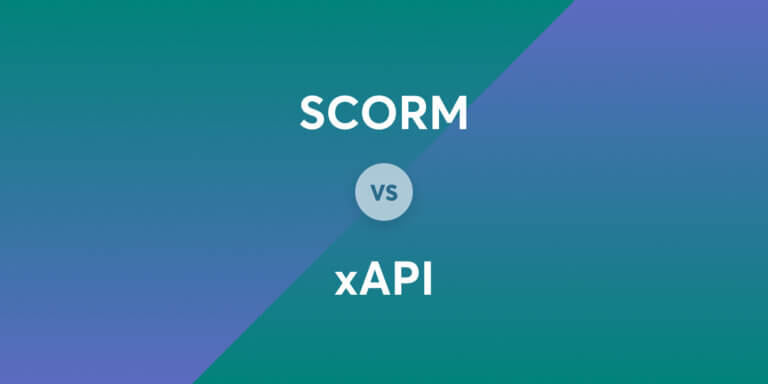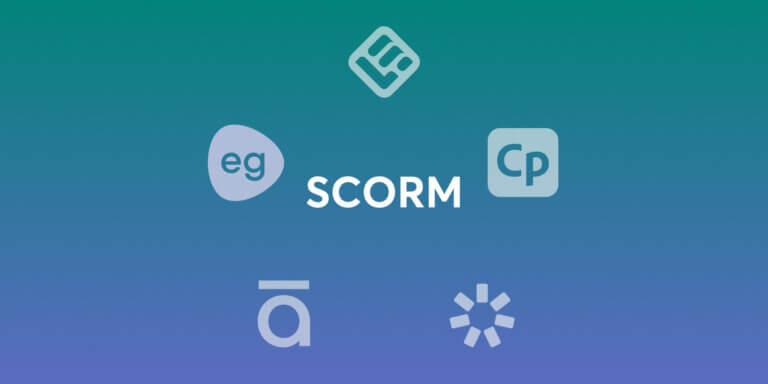Table of Contents
Learning standards have always adapted to what the market demands looked like. eLearning standards in particular brought entirely different ways of learning and acquiring knowledge. This has changed lots of preconceptions related to how we learn and progress.
SCORM and xAPI are two well-known eLearning industry standards that course creators can rely on to monitor how their students progress. There’s no point in using both at the same time though.
So in this article, I’m analyzing SCORM and xAPI differences so you can decide which one is best suited for the format of your courses and the way your students prefer to learn.
What is SCORM API?
SCORM (Sharable Content Object Reference Model) was developed by the Advanced Distributed Learning (ADL) organization, which was part of the U.S. Department of Defense in 2000. This marked the entry of one of the first eLearning standards that would later act as a benchmark for other similar standards and initiatives.
The introduction of SCORM meant different learning management systems (LMSs) could now be used for the same elearning content. SCORM compliance essentially ensures that this elearning content is universally compatible across various LMSs.
Course creators were now managing and sharing their courses more easily than ever before. In particular, SCORM API (or SCORM data model) looks at your learners’ data and progress on specific modules so you can have a more detailed look at where students stand—no matter what system you’re using to distribute your courses.
💁Need help with understanding SCORM? Check out our SCORM help guide or watch the following webinar:
Key benefits of SCORM for elearning programs
Below are some of the benefits of SCORM as an elearning standard:
However, there are a few imitations of SCORM vs xAPI.
The limitations of SCORM
Here are some of SCORM’s limitations:
| Pros of SCORM | Cons of SCORM |
| Widespread support | Can only track basic data points |
| Standard reporting | It doesn’t work offline |
| Easy to use | Not compatible with a lot of learning environments |
What is xAPI?
xAPI (Experience API, Tin Can API, or xAPI API) is an interoperability specification for learning technology that became a thing in 2013 as the industry was starting to notice the limitations behind SCORM. While SCORM focuses on delivering standardized courses, xAPI made it possible for instructors to create and track progress on non-conventional educational content.
For instance, if SCORM is best used with an LMS, you could use xAPI specification to go beyond classic online learning and tap into mobile learning and virtual reality (VR). That’s because xAPI tracks more complex learner interactions so you can learn more about how a learner behaves or what their preferences and performance results are.
Experience API xAPI also enables the creation of personalized, adaptive training programs. You can use it for corporate training to track employees’ progress and find an individual’s strengths and weaknesses. With adaptive learning in place, xAPI will adjust the difficulty of the training scenarios one receives based on their behavior and results.
Benefits of xAPI compared to SCORM
Here are the benefits of xAPI or Tin Can API vs SCORM:
The limitations of xAPI
These are some of xAPI’s limitations:
| Pros of xAPI | Cons of xAPI |
| Lots of data tracking capabilities and use cases | Requires extra data storage solutions |
| Works for offline learning too | Might not be compatible with your preferred LMS providers |
| It’s versatile | It’s complex to track data from a technical point of view |
SCORM vs Tin Cap API: A tracking comparison
The most important differentiator? The type of data each tracks. SCORM records simple data points like course completion, scores, and time spent on a learning module. In contrast, xAPI goes beyond these to track specific and diverse learning activities across multiple platforms and contexts.
SCORM can record when a learner finishes a course, their quiz scores, or how long they stayed in a particular module. xAPI can capture data around hands-on activities like completing a simulated task in virtual reality or collaborating on a group project. xAPI also gives a bit more detail when it comes to what a learner prefers, how they make decisions, and how they perform every step of the way.
How to decide between SCORM and xAPI for your needs
Now you might be wondering: Do SCORM and xAPI work together? Generally, no. They were built for separate fundamental purposes. Still, you can use both with your LMS of choice if you want to expand your tracking abilities.
If you are not sure what’s best for you in terms of SCORM vs. Tin Can API, let me take you through a couple of steps and then common scenarios that will make it easier for you to choose between these two.
Go through the following steps to help you:
Assess your learning goals and needs
The first step in deciding between SCORM and xAPI is understanding your organization’s learning goals and needs. Consider whether your focus is on delivering traditional e-learning courses or if you aim to track a wider range of learning experiences, such as on-the-job training, social learning, or mobile learning. Determine the level of detail you want to capture from learner interactions and whether your current system can support those needs.
Future-proof your learning program
When selecting a learning standard, it’s important to think long-term. Evaluate whether the solution you choose can scale with your organization and adapt to emerging technologies like virtual reality, augmented reality, and gamification.
Evaluate reporting requirements
Reporting capabilities are a critical consideration in your decision. Think about the type of data you need to collect and how it will be used to measure learning outcomes and inform decisions. Determine whether metrics like completion and scores are enough or if you require more granular data and actionable insights to identify trends and improve performance.
Consider integration needs and implementation
Finally, consider how well the solution will integrate with your existing systems and workflows. Whether you use an LMS, CRM, or other enterprise systems, the ability to seamlessly share data across platforms is essential for creating a cohesive learning ecosystem. Also, factor in the complexity of implementation, as well as the resources required for setup and maintenance.
Common scenarios to aid your decision-making
To help you decide between the two, I’ve also organized the following scenarios by decision on the differentiating factor and considering their scalability, interaction complexity, course authoring tools, and more.
1. How scalable the tool is and what your integration options are
Choose SCORM if:
Choose xAPI if:
2. How complex course interactions are
Choose SCORM if:
Choose xAPI if:
3. What course authoring tools do you have
Choose SCORM if:
Choose xAPI if:
4. How you’ll be tracking learner progress + what reporting requirements do you have
Choose SCORM if:
Choose xAPI if:
My personal recommendation is to stick with a single option so you can better manage the data and its storage options.
Consider what type of data you need to track. If you don’t want to complicate things, SCORM will do. For in-depth tracking, choose xAPI. Understand what will work best in your preferred learning environment. SCORM is a good fit for your typical online courses, while xAPI is ideal for multi-environment learning—even if it involves offline education.
And remember: No standard is more future-proof. Course creators will keep using whatever makes more sense for them. Generally, this means SCORM content for classic online courses and xAPI for everything else you want to scale.
Start building your online courses with a SCORM-compliant LMS
LearnWorlds is a versatile, modern platform supporting a wide range of course-building needs. The flexibility it offers makes it compatible with SCORM courses.
LearnWorlds SCORM compliance makes it easy to upload and integrate SCORM and HTML5 packages directly into the platform, making course delivery a breeze.
It also tracks key learning data such as course completion, learner progress, and assessment scores, storing session information so learners can pick up where they left off.
Try LearnWorlds for free to see how simple it is to upload and manage SCORM-compliant courses!
SCORM vs xAPI FAQs
Is xAPI better than SCORM?
Whether xAPI is better than SCORM or not depends on your training needs and goals. SCORM is a good starting point for conventional eLearning and it integrates well with many LMS tools you might already be using. xAPI though will be better suited for advanced learning scenarios such as virtual, mobile, or in-person training (or all at the same time). You’ll want to follow the above list of steps to find out which one you should opt for.
What are the technical differences between implementing SCORM vs. xAPI?
Simply put, xAPI requires more technical expertise and management than SCORM API. The latter can easily be connected to most LMS solutions out there but it’s fully dependent on these for storing and retrieving data.
xAPI tracks data from multiple systems and contexts and stores them in a Learning Record Store (LRS). Since data is gathered from so many platforms, xAPI uses RESTful APIs over HTTPS to send “statements” in a flexible JSON format. This makes it easier for the end user to track complex activities in real-time.
What type of training should be created with SCORM or xAPI?
Do you have a simple course? SCORM will work for most of your day-to-day training such as onboarding modules or knowledge-based certifications you already have in your LMS. With SCORM, you can also use simple learning activities such as quizzes, videos, or interactive PDFs.
xAPI, on the other hand, works best if you’re creating advanced learning scenarios that involve virtual and augmented reality, mobile learning, or real-life interactions. You’re also better off using xAPI to track progress on complete learning paths and see what the results of your learners are like with face-to-face interactions.

Alexandra Cote
Alexandra Cote is a SaaS growth marketer and online instructor who's worked with dozens of brands in the MarTech, HR tech, and productivity space. She's also a strong supporter of staying happy at work and choosing a healthy career path.




